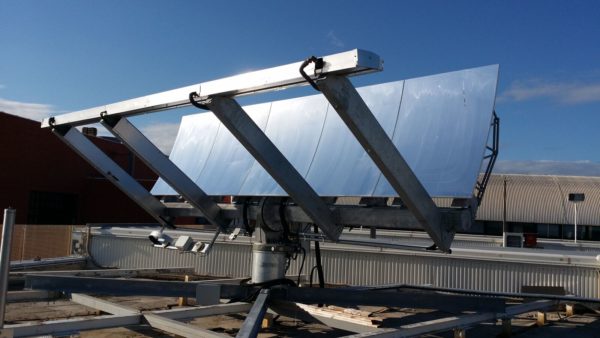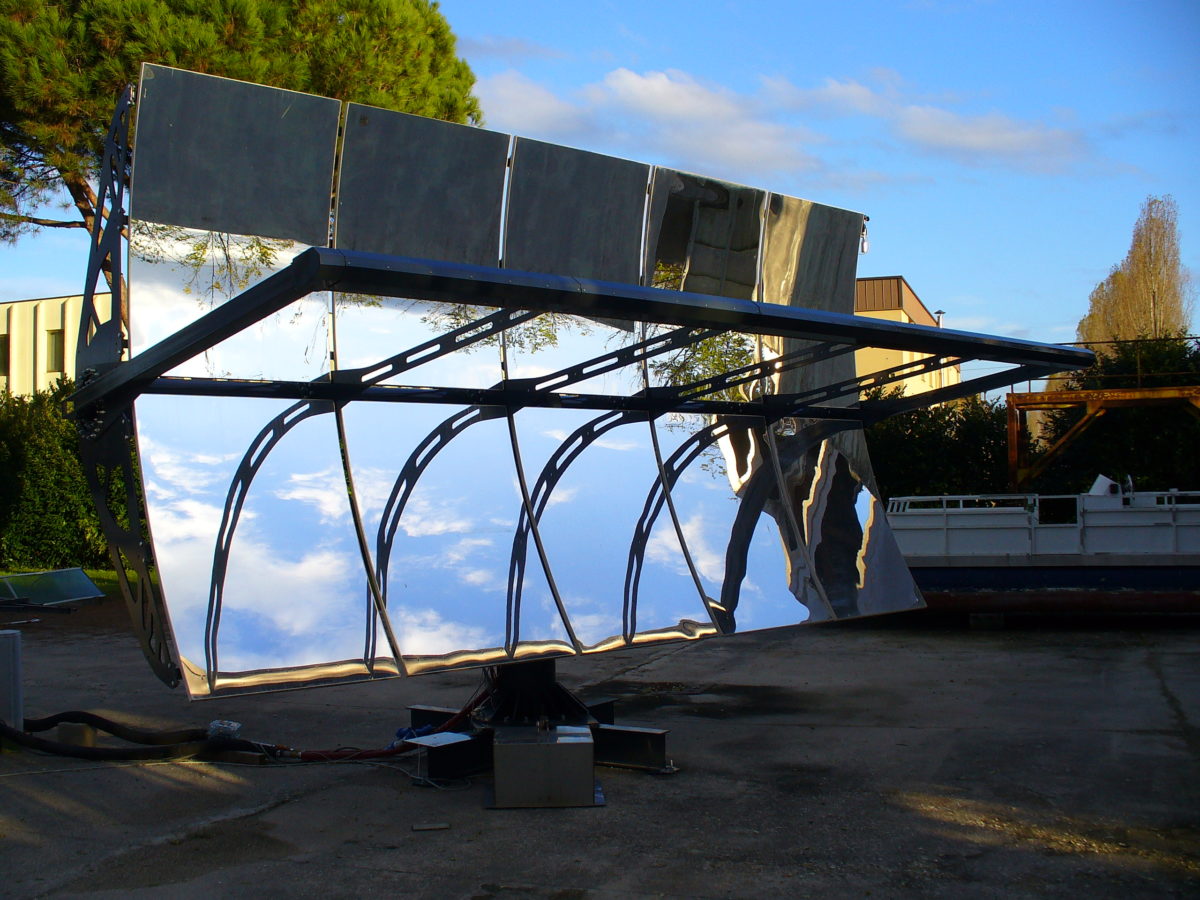Italy's Greenetica Distribution has revealed plans to commercialize a new parabolic trough linear concentrating photovoltaic-thermal (CPVT) system.
The energy company developed the system with researchers from the University of Padua's Department of Industrial Engineering. Several other entities also participated in the project, including Italy's National Agency for New Technologies (ENEA), Austria's Joanneum Research Forschungsgesellschaft mbH, and Egypt's Heliopolis University.
“The co-generating system has been patented and its launch on the market should be made soon,” one of the project participants, Antonio Sichirollo, told pv magazine. “Initially, only the thermal system will be available, while the pure photovoltaic-thermal version for the combined production of heat and electricity version should be launched in 2022.”
The latter system consists of four parabolic trough mirrors that concentrate solar radiation on a linear receiver. It includes two photovoltaic-thermal modules, each with a length of 1.2 meters.
The photovoltaic-thermal panel is equipped with multi-junction solar cells based on indium gallium phosphide (InGaP), gallium arsenide (GaAs), and germanium (Ge). They are said to exhibit a very limited dependence of efficiency on the operating temperature and can work with maximum efficiency at 80 C.
The solar cells, provided by German manufacturer Azur Space Solar Power GmbH, are soldered onto a ceramic substrate, which is linked to an active cooling system with an aluminum roll-bond heat exchanger and a closed loop to pump water as a coolant. The square cells are 10 mm long on the sides and are united into 34.6%-efficient strings, each with 22 cells. The PV unit features 10 strings and is 1.2 meters long. A double-axis tracking system was added to ensure maximum energy output.
The prototype system has an area of 6.857 square meters and a geometrical concentration ratio of nearly 130, which in an industrialized system can even reach 140, according to the manufacturer. The system is also modular, so more modules can be added.
“The industrialized system now has a different and highly performing heat exchanger always developed by Padua University team and all components into the receiver are re-engineered to implement and efficient assembly production process,” Sichirollo said.
“The CPVT module is now produced in Padua on a small-scale basis into the same factory where the thermal system is manufactured,” Sichirollo added. “Greenetica Distribution is planning to cooperate with a specialized international manufacturer to settle a mass production.”
The modularity of the system makes it suitable for a wide range of applications, from residential to large-scale projects. The standardized first model has five receivers, for a total length of 6 meters.
“It easy to install multiple system solar parks or to scale down the system up to 1.2 m length receiver to provide enough heat and electricity to a single passive house,” Sichirollo said.
The system has an efficiency of 91%, which means that this percentage of direct solar radiation is converted into heat or electricity. The peak power for an optimized, 1.2-meter CPVT receiver is 3.5 kW (1 kW electric plus 2.5 kW thermal).
“Expected power generation per year for the standard system with five modules and 6-meter receiver length is between 30,000 and 35,000 kWh in northern Italy,” Sichirollo said. “Approximately one-third for electricity and two-thirds for heat.”
The thermal version of the system has secured Solar Keymark certification, a voluntary third-party mark for solar thermal products. The certification will show end users that the product adheres to the relevant European standards.
“It is ready for the market and to get incentives in more than 40 countries,” Sichirollo added. “Grid parity, however, is already achieved on a medium-term duration and the economic return is extremely short for all the customers with full use of the thermal energy within the year.”
The current incentive for a standard full system in Italy is currently €16,725 ($19,700). “It is possible to buy directly from the company or from selected installers in case of a turnkey plant,” Sichirollo said.
The research team claims that the combination of heat and electricity production in a single system offers several advantages over the separate use of the technologies. These advantages include a lower carbon footprint, flexibility of temperature level, more peak power per square meter, stable output, and simple integration with existing plants. “And compared to a single plant, it also has a lower levelized cost of electricity,” Sichirollo added.
This content is protected by copyright and may not be reused. If you want to cooperate with us and would like to reuse some of our content, please contact: editors@pv-magazine.com.




This article was promotional in nature. Note that there was no critical analysis. Also note that the efficiency figure assumed that all the thermal energy was utilized. No mention was made of the efficiency if the log-grade thermal energy was converted into electrical energy.
Hi Vernon,
The article is intended at providing general information about the technology and doesn’t include a critical analysis, as you say. But this doesn’t mean necessarily it is “promotional in nature” and I think it is not. I am looking for the answers you are looking for in your comment, and I hope to add them soon.
Dear Vernon,
here the answers to your two questions from the system’s creators:
1) the product can be a thermoelectric cogenerator or a heat generator only. The generation of electricity only and the dissipation-waste of heat is what we wanted to avoid with this system. The 91% efficiency has been certified by Solarkeymark for the thermal version only, but substantially, as stated in the article, the same conversion of useful energy could be obtained with the thermal photovoltaic model obtaining 1/3 of electrical energy (due to photovoltaic effect) and 2/3 of thermal energy. The thermal photovoltaic model was developed before the thermal one, then commercial considerations led to the initial launch of the thermal one only.
2) The thermal energy is calculated with flowmeters and temperature probes based on the coolant used (demineralized water or demineralized water and different types of glycol). The thermal energy is not converted into electricity as, in particular at these temperatures below 100 °, it is very inefficient and therefore not convenient. In any case, the conversion of thermal energy with turbines combined with the generation of steam with superheating of low-boiling liquids or the exploitation of the thermoelectric effect for the direct conversion of heat into electricity is certainly possible.
Would they be available in Australia in PV only?